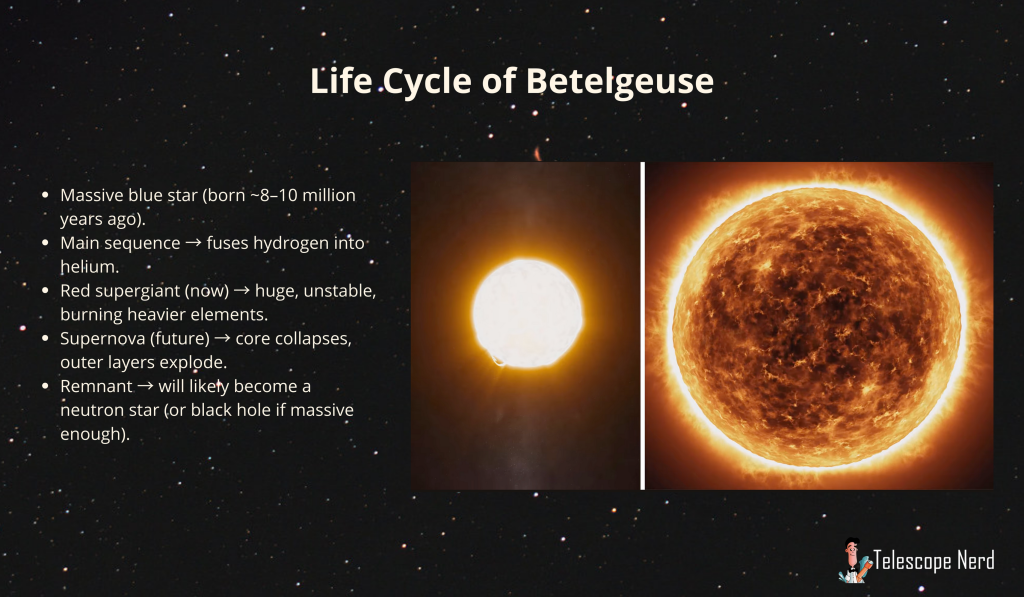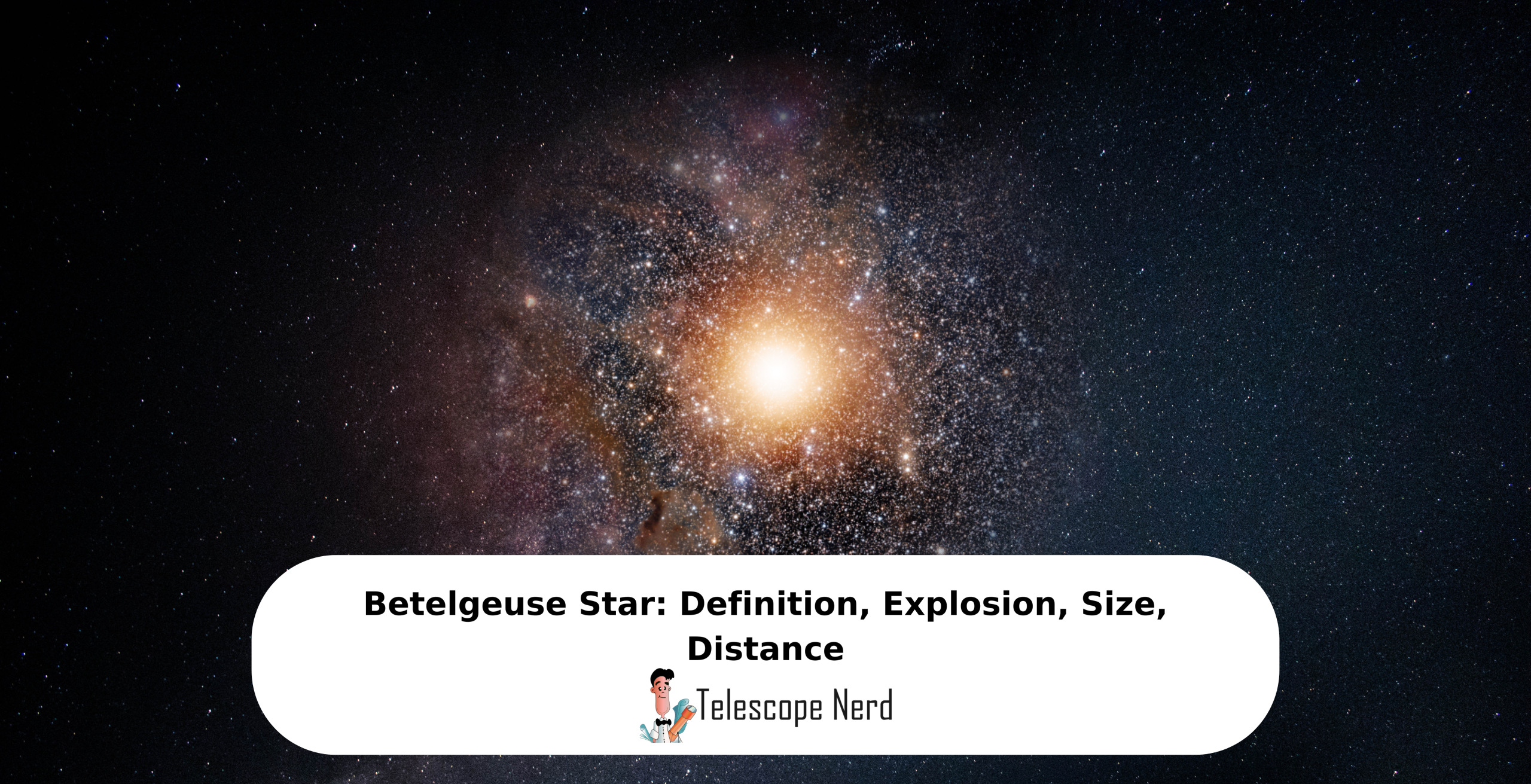Betelgeuse Star: Definition, Explosion, Size, Distance
Betelgeuse is an O-type main-sequence star. Betelgeuse is titled α Orionis (Alpha Orionis). Betelgeuse is a semiregular variable star, and it is classified as a red supergiant. Betelgeuse is an evolved red supergiant, the M1-2 Ia-ab red supergiant. Betelgeuse is a luminous and orange-red star. Betelgeuse is a dying star.
The distance of Betelgeuse from Earth has been estimated at 650 light-years, with other measurements suggesting 724 light-years. Some studies indicate a distance of 600 light-years, while others propose 548 light-years or 520 light-years. The most precise estimate gives a distance of 642.5 light-years from Earth.
What is the definition of Betelgeuse star?
The Betelgeuse star is a red supergiant star and a semiregular variable star. Betelgeuse is one of the largest stars, and it is nearing the end of its existence. Betelgeuse has an orange-red hue, and it is located in the constellation Orion.
Betelgeuse, a red supergiant, is a runaway star and it evolved from an O-type main-sequence star. Betelgeuse is a semiregular variable star. As a red supergiant star, Betelgeuse is a cool star. Betelgeuse is the second brightest in its constellation Orion, second to the blue supergiant Rigel. The name Betelgeuse was mistranslated from the Arabic phrase Ibṭ al-Jauzā’ in the 13th century, leading to the nickname “the armpit of Orion” as opposed to its actual moniker “the shoulder of Orion”. Betelgeuse is visible from both the southern and northern hemispheres. Three bright stars make up Orion’s belt and Betelgeuse can be located in the night sky by identifying these three stars. In 1603, German astronomer Johann Bayer gave the star its Latin name Alpha Orionis, with alpha meaning the brightest star in its constellation. Scaliger Betelgeuze was taken from Johann Bayer’s Uranographia. Two bright stars represent Orion’s shoulders and Betelgeuse marks one of the shoulders of Orion. Betelgeuze comes from an etymologizing reinterpretation of Beldelgenze.

Is the star Betelgeuse about to explode?
Betelgeuse may be about to explode, as the star is nearing the end of its lifespan. When Betelgeuse explodes as Type II supernovae, the star will go off as a supernova making it the closest supernova to Earth, shining as brightly as a half-Moon.
In 2019, Betelgeuse started dimming in brightness. The star dimmed to about 60% of its brightness within the first few months, an event known as the Great Dimming. Stars start dimming before explosion, a phase known as “pre-supernova”. The sudden dimming caused scientists to anticipate a possible explosion of the star. By April of 2020, the star had reverted to its original brightness. While the star is expected to explode into a supernova, scientists do not expect it to occur for about 100,000 years.
What is the size of Betelgeuse?
The size of Betelgeuse can be estimated on the basis of its solar radii. Betelgeuse has an estimated radius of 764 solar radii, roughly corresponding to 531.5 kilometers, or 3.6 AU. If placed at the center of the Solar System, the star would engulf Earth and extend past Jupiter. A study published in 2022 proposed a solar radii of 640 following the Great Dimming event. The angular measurement of the star in 2008 was 47.0 ± 0.1 milliarcseconds, as opposed to 56.0 ± 0.1 milliarcseconds observed in 1993. The star shrunk by 0.9 AU in 15 years.
Does Betelgeuse have planets?
Betelgeuse does not have planets. Although Betelgeuse has a habitable zone, it may be binary, which affects the likelihood of it having any planets.
How far is Betelgeuse?
Betelgeuse’s distance ranges from 400 to 600 light-years from the Sun. The star is often described as being 640 light-years away from Earth, while other sources place it at 650 light years from Earth. Some studies suggest Betelgeuse’s distance is closer to 548 light-years. Betelgeuse distance can reach up to 1,300 light years or 6 quadrillion km away. The parallax measurements for Betelgeuse are recorded as 5.95 +0.58 −0.8 mas, while another study reports a parallax of 7.63 ± 1.64 mas. These varying figures reflect ongoing efforts to refine our understanding of this star’s true distance.

How long is the life cycle of Betelgeuse?
Betelgeuse has a life cycle longer than the 400-day cycle typical of semiregular variable stars. Betelgeuse has an age of 10 million years and a core that has exhausted its hydrogen. The star fused helium into carbon and evolved into a red supergiant after being a blue supergiant. Betelgeuse will become a black dwarf at the end of its life cycle. A red supergiant has a lifetime of a few million years. A semiregular variable star stretches about five years in its cycle. Massive stars experience an energetic and violent end. A blue supergiant evolves into a red supergiant. Supergiants use up their fuel within a few million years.

A red supergiant passes through the brief yellow supergiant phase, where it expands and cools. Semiregular variable stars have cycles longer than 400 days which includes the red giant phase. Supergiants become black dwarfs, using up the hydrogen and helium in their cores. Massive stars explode as supernovae. Very massive stars use up their fuel quickly. Supergiants start to burn carbon and eventually stop glowing. Supergiants contain a core of iron. A supernova scatters materials inside the star. A red supergiant can explode as a blue supergiant. Variable stars undergo irregular light changes.

